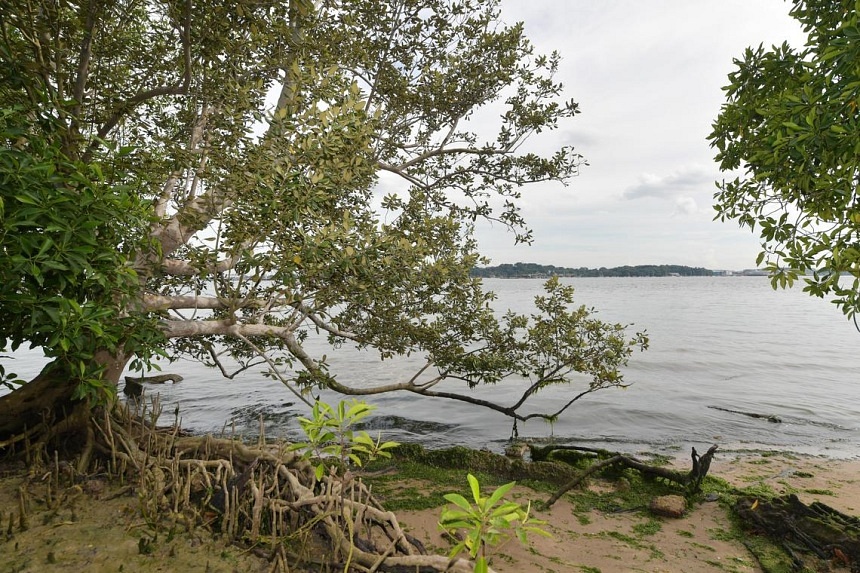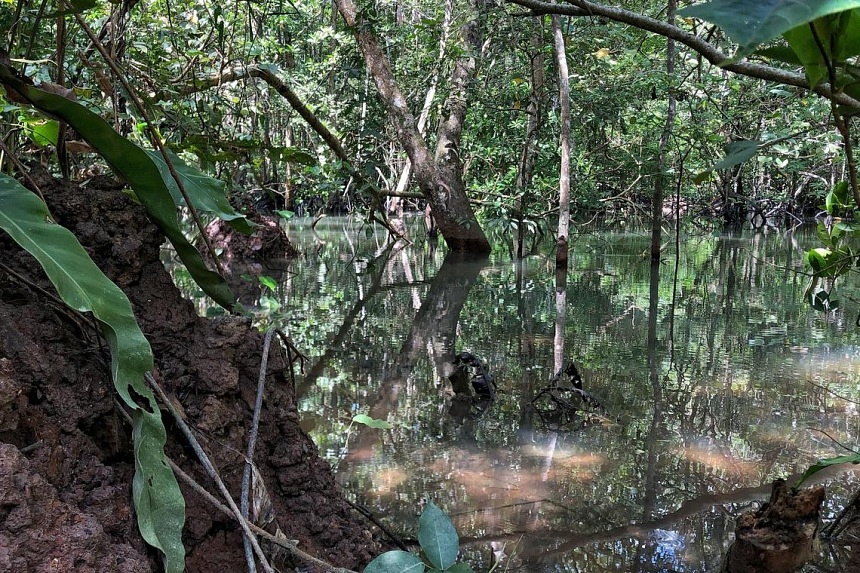
Mangroves can store and lock carbon in the ground as they take in carbon dioxide through photosynthesis. They can store three to five times more carbon compared with tropical forests.
ST
Ariel Yu
Updated
Sep 23, 2024
SINGAPORE – Planting mangroves can yield many benefits such as coastal protection and biodiversity improvement, but a new study has found that planted stands of mangrove trees cannot hold up against a natural, untouched mangrove forest in one key aspect: carbon storage.
Planted mangrove trees can store up to 71 per cent to 73 per cent of the carbon found in an intact mangrove forest of the same coastal environment, and this level of carbon storage is achieved only after around 20 years of growth, the study shows.
Researchers say this finding shows that replanting new mangroves cannot fully compensate for the loss of untouched forests.
The study defines planted mangroves as areas where mangrove vegetation was deliberately planted either where they had previously existed, such as in a degraded area, or where no mangroves had existed before.
The co-lead researcher of the study, Dr Carine Bourgeois of the US Forest Service International Programme (Central Africa and Middle East), said their models indicate that even if all highly restorable mangrove areas were replanted, they would only capture and store 0.025 per cent of annual global carbon dioxide emissions over 20 years, assuming restoration achieves similar success in building up carbon stocks.
“To put this in perspective, mangroves globally hold 11.7 petagrams of carbon, equivalent to 1.15 times the annual global carbon dioxide emissions. This highlights the importance of conserving existing mangrove carbon stocks,” she added. A petagram is equivalent to a billion metric tonnes.
The study’s publication in the Science Advances journal in July comes amid a global resurgence of interest in nature restoration, including replanting mangroves, as a nature-based solution to tackle climate change.
Mangroves can store and lock carbon in the ground as they take in carbon dioxide through photosynthesis. They can store three to five times more carbon compared with tropical forests.
“Despite the perceived benefit of restoration, there is now no consensus on the timeline required for successful planted mangrove stands to recover or build up levels of carbon stocks similar to natural mangrove forests,” noted the research team, which involved 24 researchers from institutions such as the Institute of Pacific Islands Forestry, the Centre for International Forestry Research and World Agroforestry, University of Malaya and University of Cambridge.

Ariel Yu
Updated
Sep 23, 2024
SINGAPORE – Planting mangroves can yield many benefits such as coastal protection and biodiversity improvement, but a new study has found that planted stands of mangrove trees cannot hold up against a natural, untouched mangrove forest in one key aspect: carbon storage.
Planted mangrove trees can store up to 71 per cent to 73 per cent of the carbon found in an intact mangrove forest of the same coastal environment, and this level of carbon storage is achieved only after around 20 years of growth, the study shows.
Researchers say this finding shows that replanting new mangroves cannot fully compensate for the loss of untouched forests.
The study defines planted mangroves as areas where mangrove vegetation was deliberately planted either where they had previously existed, such as in a degraded area, or where no mangroves had existed before.
The co-lead researcher of the study, Dr Carine Bourgeois of the US Forest Service International Programme (Central Africa and Middle East), said their models indicate that even if all highly restorable mangrove areas were replanted, they would only capture and store 0.025 per cent of annual global carbon dioxide emissions over 20 years, assuming restoration achieves similar success in building up carbon stocks.
“To put this in perspective, mangroves globally hold 11.7 petagrams of carbon, equivalent to 1.15 times the annual global carbon dioxide emissions. This highlights the importance of conserving existing mangrove carbon stocks,” she added. A petagram is equivalent to a billion metric tonnes.
The study’s publication in the Science Advances journal in July comes amid a global resurgence of interest in nature restoration, including replanting mangroves, as a nature-based solution to tackle climate change.
Mangroves can store and lock carbon in the ground as they take in carbon dioxide through photosynthesis. They can store three to five times more carbon compared with tropical forests.
“Despite the perceived benefit of restoration, there is now no consensus on the timeline required for successful planted mangrove stands to recover or build up levels of carbon stocks similar to natural mangrove forests,” noted the research team, which involved 24 researchers from institutions such as the Institute of Pacific Islands Forestry, the Centre for International Forestry Research and World Agroforestry, University of Malaya and University of Cambridge.

A mangrove area on Pulau Ubin in October 2022. Researchers say the new study shows that replanting new mangroves cannot fully compensate for the loss of untouched forests. ST PHOTO: ALPHONSUS CHERN
This information gap prompted the researchers to embark on the study to assess whether planted mangroves demonstrate a similar ability to store carbon as natural primary stands, including mangrove forests that were free from human degradation.
They found that despite an increase of 25 per cent of carbon stock in soil in the first five years after planting mangroves, there was not much change thereafter as the amount stayed at about 75 per cent between five and 40 years after planting compared with existing mangrove forests.
For the study, the research team analysed previous studies of 684 planted mangrove stands in 24 countries, spanning 40 years of data.
Dr Bourgeois said that 77 per cent of the team’s entire database was collated from countries in the Indo-Malaysian region, including Singapore, Bangladesh, Cambodia, Indonesia, Malaysia and Vietnam
This information gap prompted the researchers to embark on the study to assess whether planted mangroves demonstrate a similar ability to store carbon as natural primary stands, including mangrove forests that were free from human degradation.
They found that despite an increase of 25 per cent of carbon stock in soil in the first five years after planting mangroves, there was not much change thereafter as the amount stayed at about 75 per cent between five and 40 years after planting compared with existing mangrove forests.
For the study, the research team analysed previous studies of 684 planted mangrove stands in 24 countries, spanning 40 years of data.
Dr Bourgeois said that 77 per cent of the team’s entire database was collated from countries in the Indo-Malaysian region, including Singapore, Bangladesh, Cambodia, Indonesia, Malaysia and Vietnam
Mangroves around the world are usually found in tropical and subtropical coastal areas because they thrive in environments with warm temperatures, high humidity and abundant rainfall throughout the year.
Globally, mangrove coverage shrank by 3.4 per cent between 1996 and 2020.
The lost coverage of 5,245 sq km is slightly smaller than the size of Brunei, according to the UN Environment Programme’s biodiversity centre, which provides data analysis on global biodiversity and environmental issues.
The loss in mangrove coverage is about seven times the size of Singapore. It is estimated that more than 20 per cent to 35 per cent of the world’s mangroves have been decimated over the past 50 years, and it is mainly due to human activities such as agriculture, aquaculture and urban development, and natural challenges such as erosion and extreme weather.

Mangroves around the world are usually found in tropical and subtropical coastal areas. ST PHOTO: JOEL CHAN
Professor Daniel Friess, a mangrove expert from Tulane University, who was not involved in the latest study, said the research showed that planted mangroves were still able to bring back a proportion of the carbon lost when the mangroves were removed.
“This study provides further incentive to restore mangroves in Singapore and the region to help mitigate climate change, but nothing beats conserving what we already have and not losing it in the first place,” he added.
Singapore has experienced a significant decline in its natural mangrove forests. An estimated 85 per cent of mangroves and tidal flats and 43 per cent of seagrass meadows have been lost, mostly since 1953, according to a 2023 study conducted by Prof Friess and researchers from institutes such as NUS, NTU and Old Dominion University.
In the 1820s, mangroves covered 13 per cent of Singapore’s land. Now, only 0.5 per cent remains, housing more than 30 mangrove species.
Given that Singapore has lost the majority of its mangroves, the study offers a positive outlook on the potential for restoration, said Dr Radhika Bhargava, a research fellow at NUS’ department of geography.
“Investing in bringing back the nature that does its job of reducing carbon emissions could help in bringing a more carbon-neutral economy forward... It’s something that Singapore can take action on right away,” she added.
However, Assistant Professor Tang Hao from NUS’ geography and biological sciences departments noted that planting mangroves does not necessarily guarantee a high carbon stock. This is because carbon accumulation is subject to local environmental conditions, and many plantation attempts have failed because the mangrove species were planted in an unsuitable place.
“Thus, for areas with lack of space but rich in mangrove habitats, it is more efficient to invest in conservation and protection of primary mangrove forests rather than simply expanding plantations into new areas with no suitability analysis,” he added.
Professor Daniel Friess, a mangrove expert from Tulane University, who was not involved in the latest study, said the research showed that planted mangroves were still able to bring back a proportion of the carbon lost when the mangroves were removed.
“This study provides further incentive to restore mangroves in Singapore and the region to help mitigate climate change, but nothing beats conserving what we already have and not losing it in the first place,” he added.
Singapore has experienced a significant decline in its natural mangrove forests. An estimated 85 per cent of mangroves and tidal flats and 43 per cent of seagrass meadows have been lost, mostly since 1953, according to a 2023 study conducted by Prof Friess and researchers from institutes such as NUS, NTU and Old Dominion University.
In the 1820s, mangroves covered 13 per cent of Singapore’s land. Now, only 0.5 per cent remains, housing more than 30 mangrove species.
Given that Singapore has lost the majority of its mangroves, the study offers a positive outlook on the potential for restoration, said Dr Radhika Bhargava, a research fellow at NUS’ department of geography.
“Investing in bringing back the nature that does its job of reducing carbon emissions could help in bringing a more carbon-neutral economy forward... It’s something that Singapore can take action on right away,” she added.
However, Assistant Professor Tang Hao from NUS’ geography and biological sciences departments noted that planting mangroves does not necessarily guarantee a high carbon stock. This is because carbon accumulation is subject to local environmental conditions, and many plantation attempts have failed because the mangrove species were planted in an unsuitable place.
“Thus, for areas with lack of space but rich in mangrove habitats, it is more efficient to invest in conservation and protection of primary mangrove forests rather than simply expanding plantations into new areas with no suitability analysis,” he added.
No comments:
Post a Comment